Do you have pomegranates in your kitchen or garden and have noticed a sudden infestation of fruit flies? Having these little bugs around your home can be a real nuisance! Fortunately, you can take some practical measures to eliminate fruit flies in pomegranates. So, let’s get started! Pomegranates are delicious and healthy fruit packed with antioxidants, vitamins, and minerals. However, the pomegranate fruit fly (Ceratitis capitata) can be a significant problem for growers and home gardeners alike.
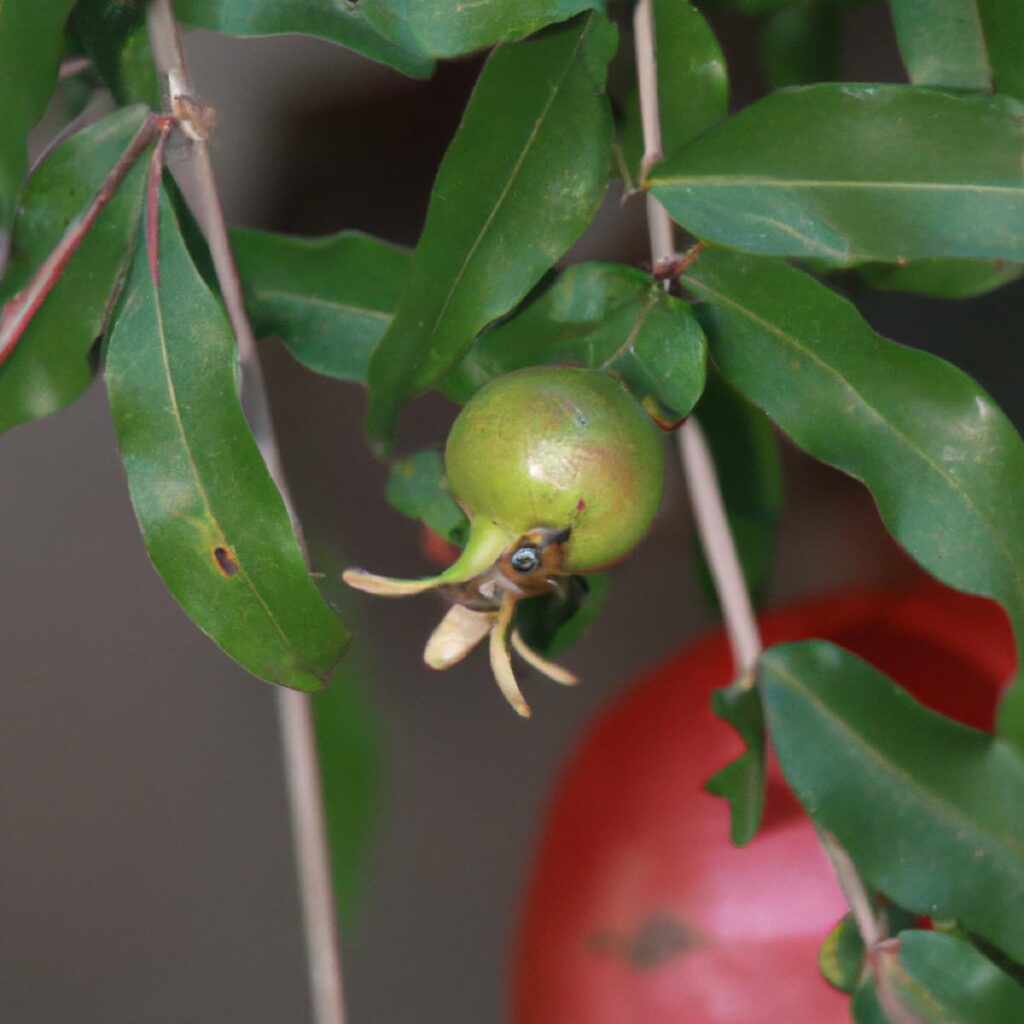
These small insects lay their eggs inside the fruit, causing it to decay and lose marketability. Fruit flies, on the other hand, attack fruits often, particularly during the fruit’s growth and ripening stages, causing growers to lose 25-30% of their yield. Fruits infected with fruit flies lose quality and attract a significantly reduced market value and demand, resulting in a financial loss for growers.
Fruit fly infections in pomegranate orchards can result in considerable fruit damage, resulting in lower production and quality. This blog article post will discuss the various methods for getting rid of pomegranate fruit flies and protecting your pomegranate crop from damage, with the best natural remedies and organic, biological, and chemical methods to manage fruit flies.
About the Pomegranate Plant
The pomegranate tree, scientifically known as Punica granatum, is a deciduous shrub or small tree grown in Iran and the Himalayas. It is widely and extensively cultivated in many parts of the world for its edible fruit, a bright red berry containing juicy seeds. Pomegranates are known for their high levels of antioxidants and are often used in juice, jams, and jellies. The pomegranate tree is a hardy plant that can tolerate many soil conditions but prefers well-drained soils.
It is drought-tolerant and can withstand temperatures at low levels. Pomegranates typically bloom in late spring, and the fruit ripens in late summer or early fall. One of the major insect pests of pomegranates is the pomegranate butterfly (Virachola isocrates). This butterfly’s larvae feed on the pomegranate tree’s leaves, causing severe defoliation. Adult butterflies are also known to feed on the nectar of the flowers, potentially reducing fruit set.
Major insect pest of Pomegranates
Pomegranate fruit fly (Ceratitis capitata)
It is a major pest of pomegranates. This insect is a small, yellowish-brown fly about 6-8 mm in length. The adult fly has a characteristic pattern of dark spots on its wings. The pomegranate fruit fly is native to Africa. Still, it has spread to many other parts of the world, including Asia, Europe, and North and South America.
In case you missed it: Growing Pomegranate Organically in Maharashtra: Farming Practices and Production Guide
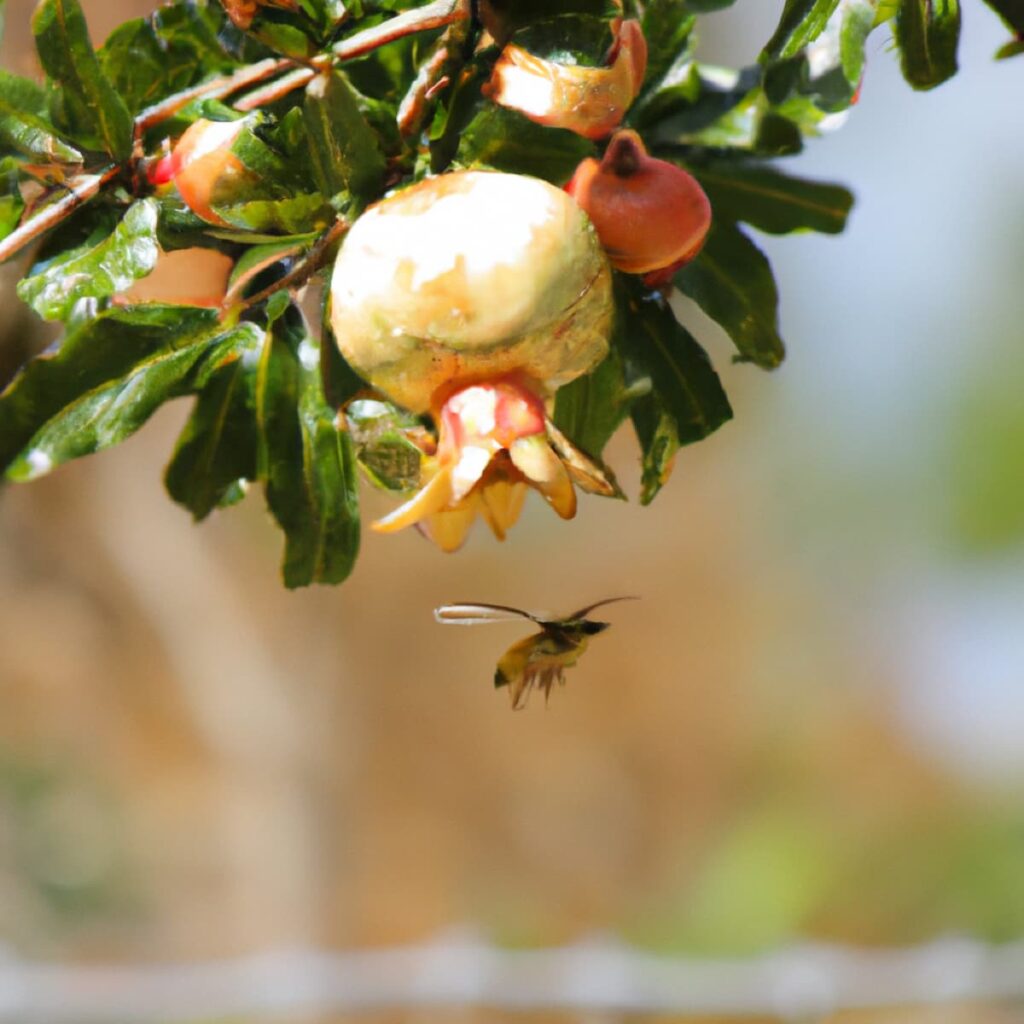
The female pomegranate fruit fly lays her eggs in the fruit, usually near the stem end. The eggs hatch into maggots, which burrow into the fruit and feed on the flesh. As the larvae grow, they cause the fruit to become soft and discolored. Eventually, the fruit may rot and fall to the ground.
Pomegranate fruit borer (Euzophera semifuneralis)
It is a serious pest known to cause extensive damage to the fruit. This insect is a small, black beetle that feeds on the stem and leaves of the pomegranate plant. The damage caused by this insect can lead to the death of the entire plant. Farmers use chemical and cultural control methods to control the pomegranate fruit borer, such as using insecticides and pruning the affected branches.
Pomegranate butterfly (Virachola isocrates)
This butterfly is known to feed on the leaves of the pomegranate plant, and it can cause significant damage to the foliage. This insect can be controlled by using insecticides and maintaining a clean and healthy environment around the pomegranate plants. Pomegranate scale (Pseudaulacaspis pentagona) is another major pest of pomegranates.
This insect is a small, brown scale that feeds on the leaves and fruit of the pomegranate plant. The damage caused by this insect can lead to reduced fruit production and quality. Farmers use chemical and cultural control methods, such as insecticides and maintaining a clean and healthy environment around the pomegranate plants to control the pomegranate scale.
Identification of Pomegranate fruit fly
Identifying the pomegranate fruit fly (Ceratitis capitata) is crucial in controlling and preventing damage to your crop. The adult fly is small, measuring 6-8 mm in length, with a yellowish-brown body and characteristic dark spots on its wings. The most noticeable sign of a pomegranate fruit fly infestation is the presence of soft, discolored fruit that has fallen to the ground.
It results from the larvae burrowing into the fruit and feeding on the flesh. Another way to identify the pomegranate fruit fly is by observing the presence of its eggs. The eggs are small, white, and oval-shaped and are usually found near the stem end of the fruit. As the eggs hatch, the larvae will begin to burrow into the fruit, causing it to become soft and discolored.
Factors contributing to Pomegranate fruit fly infestations
The presence of adult fruit flies and their larvae in the soil can contribute to pomegranate fruit fly infestations. Implementing control techniques that target adult flies and their larvae is essential. Pomegranate fruit flies are prevalent in other crops, such as watermelon, muskmelon, gourds, lemons, guava, papaya, etc.
In case you missed it: Growing Coriander Organically in Madhya Pradesh: Cultivation and Production Management
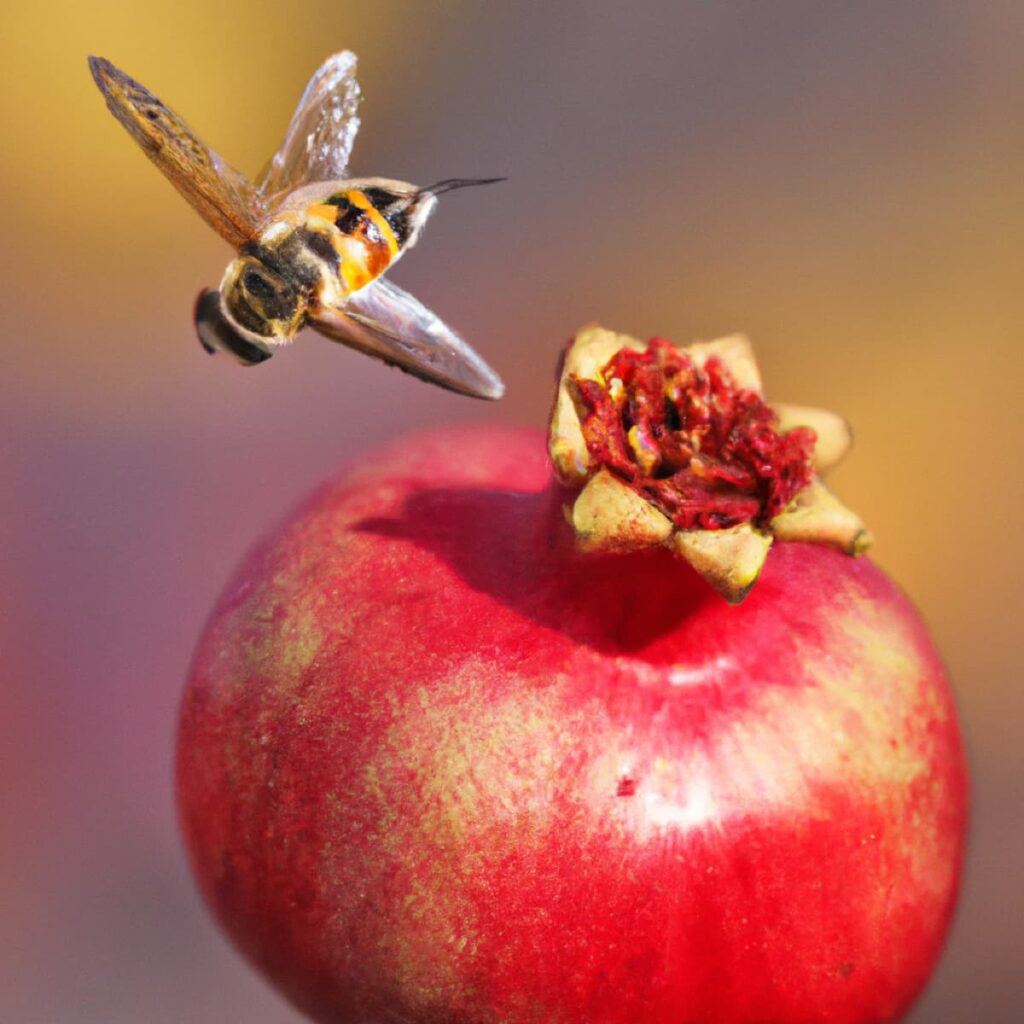
They can be exacerbated by being near a pomegranate orchard. Growing several types of pomegranate with distinct maturity cycles in the same orchard can also exacerbate fruit fly infestations. Weeds can act as an alternate host for fruit flies. Infested fruits that fall into the plot or near the fruit packaging unit can also be a problem, making control more difficult.
Pomegranate fruit fly: Symptoms, Treatment
The adult flies are small, about 3-4 mm long, and have a yellowish-brown body with black spots on their wings. The females have a saw-like ovipositor used to lay eggs on the fruit. The eggs hatch into small, white larvae that burrow into the fruit, causing damage and reducing the quality of the pomegranates. Symptoms of pomegranate fruit fly infestations include the presence of adult flies around the pomegranate trees, small puncture marks on the fruit, and small, white larvae inside the fruit.
As the larvae feed on the fruit, they can become soft and mushy and develop dark-colored spots. In severe cases, the fruit may become unmarketable and must be discarded. Treatment for pomegranate fruit fly infestations can include a combination of cultural, chemical, and biological control methods. Cultural control methods include proper orchard management practices such as pruning, maintaining a clean orchard, and removing any infested fruit from the trees. Chemical control methods include pesticides such as malathion, carbaryl, and spinosad.
These pesticides should be applied according to the label’s instructions. Care should be taken to avoid damaging beneficial insects such as bees and ladybugs. It is also important to rotate the use of pesticides to prevent the development of pesticide resistance in fruit flies. Biological control methods include using natural predators such as parasitic wasps and nematodes. These predators can help control the fruit flies’ population and reduce the need for chemical pesticides.
How to prevent fruit flies?
Tips and strategies for preventing and controlling fruit fly infestations in a household setting, including identifying and removing sources of food and breeding sites for the flies, keeping the living space dry, cleaning the trash regularly, washing all produce, throwing away rotten fruits and vegetables, keeping cans covered, changing expired soil, and thoroughly checking purchases.
Tips to control or get rid of fruit fly in Pomegranate
- Clean up any fallen fruit or debris from the pomegranate tree and the surrounding area. Fruit flies are attracted to rotting fruit, so removing this food source can help reduce their population.
- Make a trap using apple cider vinegar and a few drops of dish soap. Mix the ingredients in a bowl or jar and place it near the pomegranate tree. The fruit flies insect attracted to the vinegar and drowns in the soap solution.
- Use natural insecticides like neem oil or pyrethrin to spray the pomegranate tree and the surrounding area. These natural substances are toxic to fruit flies and can help control their population.
- Seal any cracks or openings in the walls and windows of your home to prevent fruit flies from entering.
- Keep the area around the pomegranate tree clean and free of rotting fruit or debris.
- Consider using sticky traps, which are coated with a sticky substance that traps and holds the fruit flies.
- If you have a lot of flies, consider using a fruit fly trap. They are specially designed to attract the flies, and once they enter the trap, they cannot escape.
In case you missed it: Growing Potatoes Organically in Uttar Pradesh: Varieties, Cultivation Practices, and Production Management
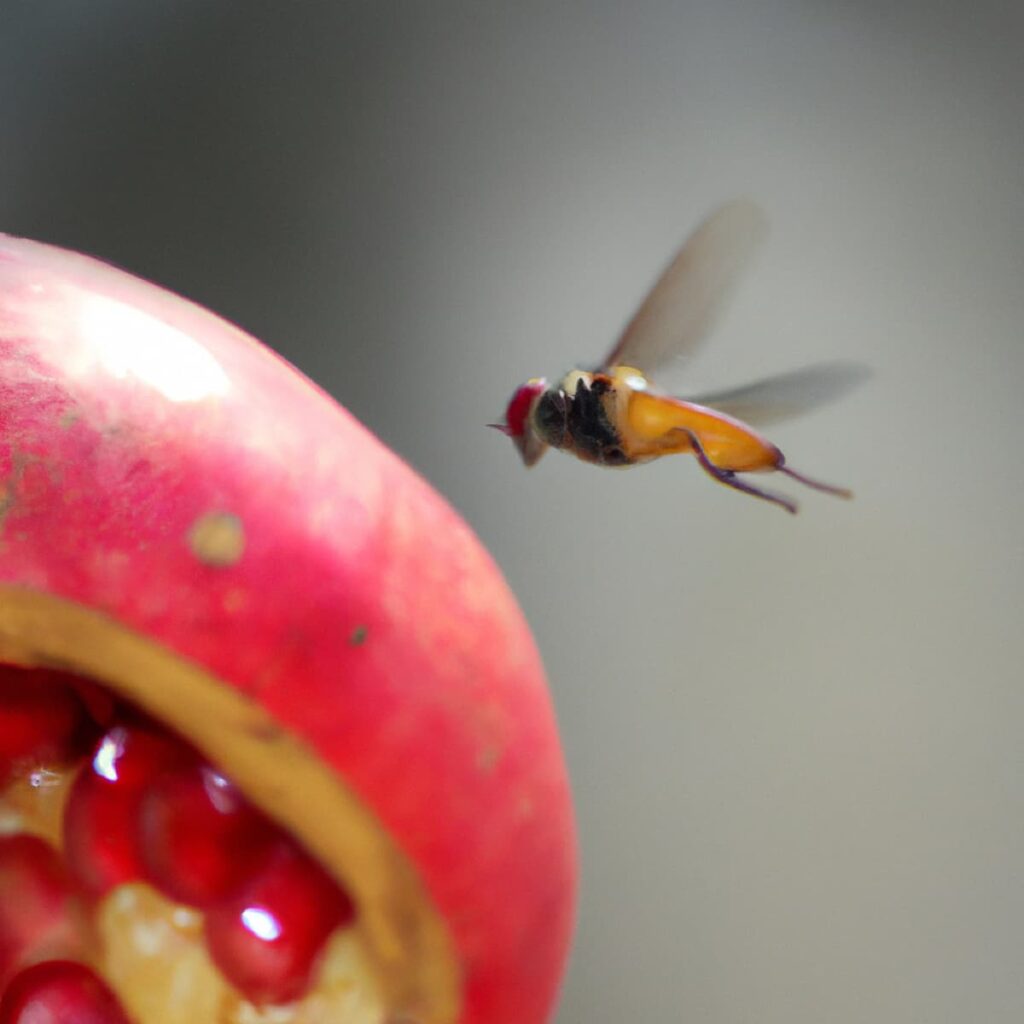
Home remedies for Pomegranate fruit flies
| Apple Cider Vinegar Wrap | Rotten Fruit Pulp Trap |
| Candle and Water Trap | Use Yellow Sticky Traps |
| Homemade Non-toxic Sprays | Vinegar and Dish Soap |
| Product for Fruitfly Traps | Wine or Beer Bottle Trap |
How to make fruit trap at home to control fruit flies
Method 1
- Take a small bowl or jar and add about an inch of apple cider vinegar to the bottom.
- Add a few ml of dish soap to the vinegar, and stir to combine.
- Place the bowl or jar near the pomegranate tree or other area where you have noticed fruit flies.
- Cover the bowl or jar with plastic wrap and drill a few small holes in the top using a toothpick or similar tool.
- The fruit flies are attracted to the vinegar and enter the bowl or jar through the holes. Once inside, the dish soap will cause the fruit flies to drown.
- Dispose of the dead fruit flies and replace the vinegar and soap solution as needed.
In case you missed it: Farming Loans in India: How to Apply, Bank Process, Rates, and Funding for Agricultural Startups
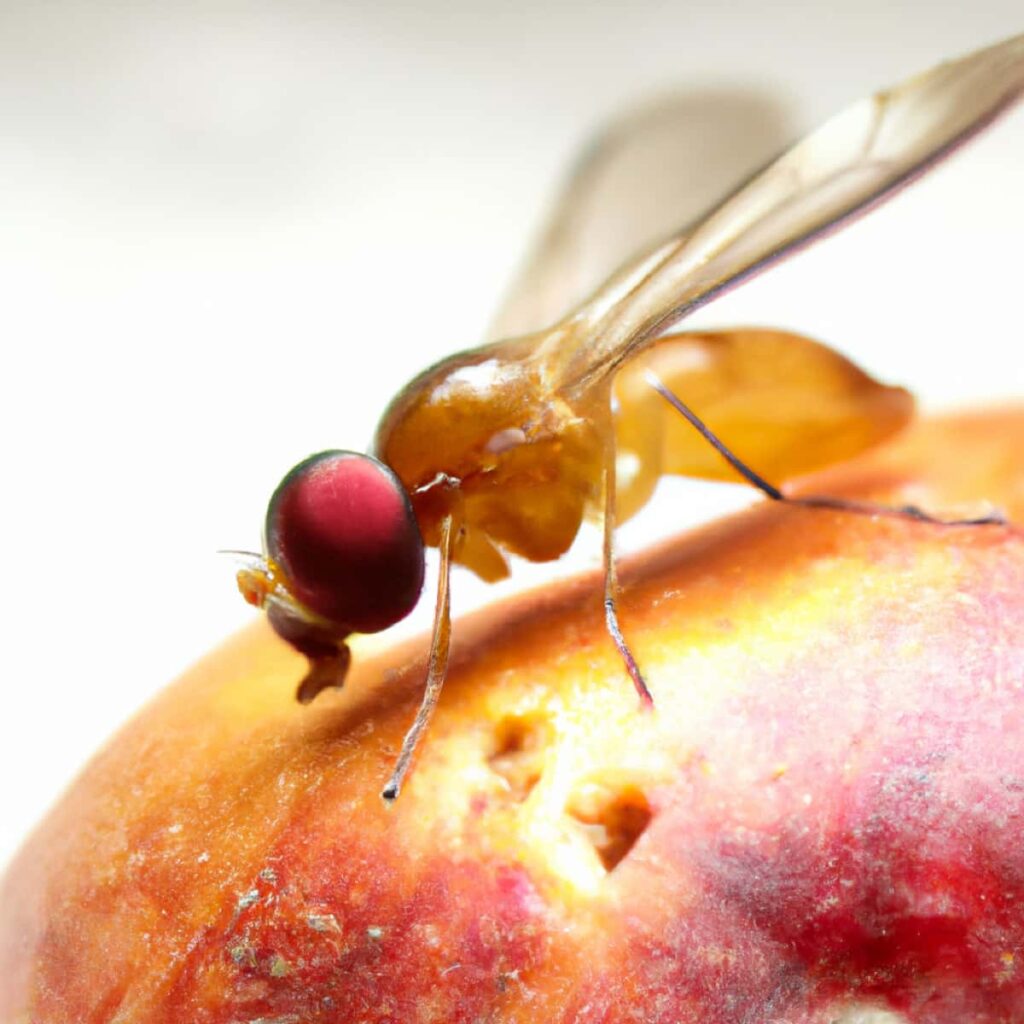
Method 2
- Use a clean soft-drink bottle (with a lid).
- Make three holes in the bottle (about the size of a ten-cent piece) 10cm from the top.
- Prepare the bait by combining 1 cup of fresh fruit juice (including pulp) and one tablespoon of hazy ammonia in a bottle.
- Tie a string around the bottle’s neck and hang it from a tree in a shaded location, about 1 to 1.5 meters above the ground.
- For optimal results, adjust the mixture regularly.
Note: These traps may also attract beneficial insects.
Chemical methods to control fruit fly in Pomegranate
Chemical control is one option for controlling fruit fly populations in pomegranates. Several insecticides can be used, including organophosphates, pyrethroids, and neonicotinoids.
- Organophosphates, such as malathion, are toxic to fruit flies and can be sprayed on the pomegranate tree and surrounding area to control their population. However, these chemicals can harm beneficial insects and other animals and should be used cautiously.
- Neonicotinoids, such as imidacloprid, are a newer insecticide class targeting the nervous system of fruit flies and other insects. These chemicals have low toxicity to mammals. Still, they can adversely affect beneficial insects and other animals, so care should be taken when using them.
- Spinosad: This chemical is derived from a naturally occurring soil bacterium and can be used as a foliar spray or soil drench to control fruit flies. It targets the nervous system of insects and is relatively safe for mammals and other beneficial organisms.
- Abamectin: This chemical is derived from a soil-dwelling bacteria and can be used as a foliar spray or soil drench to control fruit flies. It works to disrupt the nervous system of insects.
When using chemical control methods, it is essential to follow the instructions on the insecticide label carefully. It will ensure that you use the correct amount of the chemical and apply it at the right time to achieve the best results.
In case you missed it: Profitable Organic Eggplant/Brinjal Cultivation in West Bengal: A Production Guide for Beginners
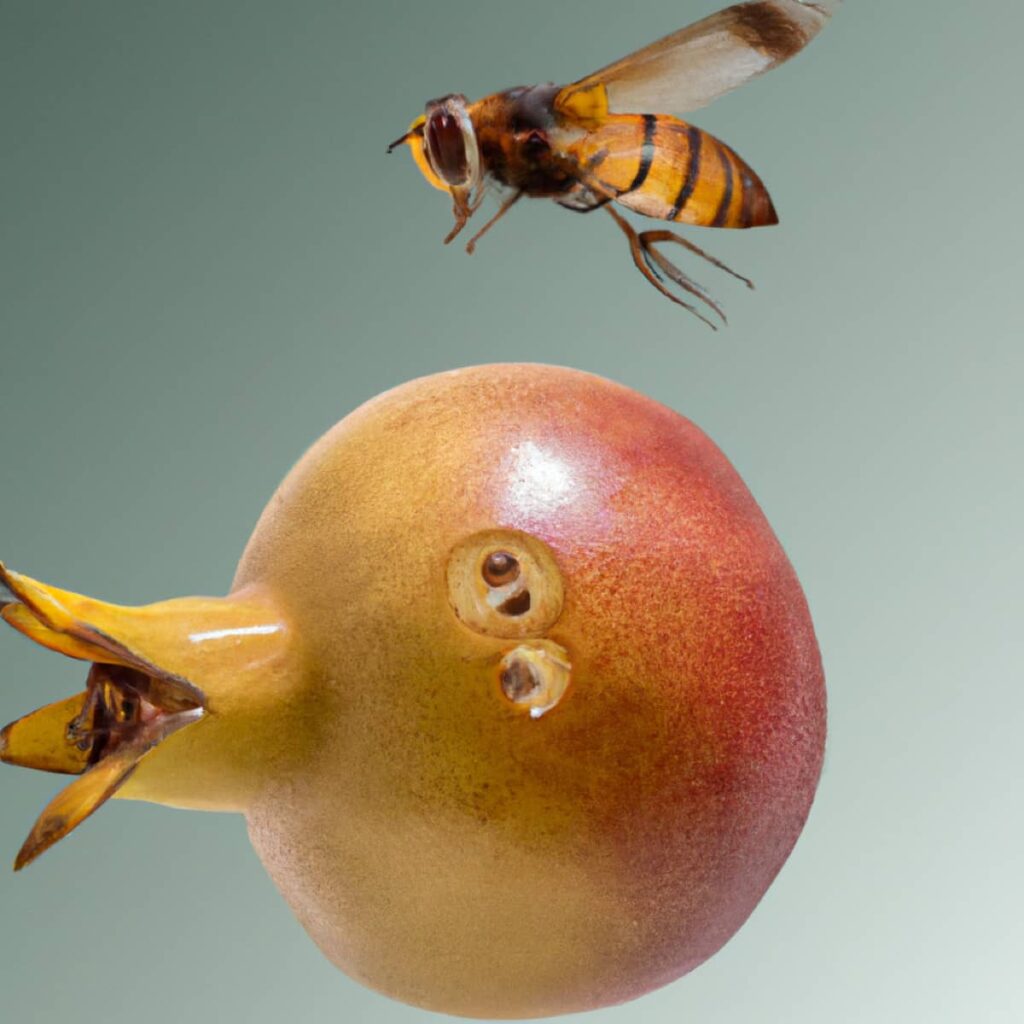
Conclusion
To effectively manage and control fruit fly populations, it is important to implement a combination of trapping, sanitation, and chemical or organic control methods. Several insecticides are available in the market regarding chemical control, including organophosphates, pyrethrins, neonicotinoids, spinosad, and abamectin.
However, it is important to use these chemicals with caution, following the instructions on the label carefully, and rotating the use of different chemicals to prevent resistance from developing. On the other hand, organic control methods include using natural predators like parasitic wasps, natural insecticides like neem oil or pyrethrin, and making homemade traps with apple cider vinegar and dish soap. These methods are more environmentally friendly but may not be as effective as chemical control methods.
- Management Pests and Diseases in Your Cotton Field
- Sheep Farming Business Plan for Beginners
- Aquaponic Farming at Home: A Step-By-Step Guide
- Profitable Village Farming Business Ideas in 2024
- High-Yield Aquaculture: Fast-Growing Fish for Farming
- Effective Fish Pond Construction Techniques for Beginners
- Irrigation and Water Management in Pineapple Farming
- Blossom to Harvest: Mastering Flowering and Pollination in Papaya Farming
- Pig Fattening Essentials: From Selection to Sale for Beginners
- Raising Wagyu Cattle: A Complete Guide for Premium Beef Production
- Soil Types and Their Water Holding Capacity
- Optimizing Irrigation Schedules for Coconut Groves for Enhanced Yield
- Espresso Your Garden: Coffee Grounds for Healthier Acid-Loving Plants
- The Best Soil Mix for Snake Plants: How to Mix Your Own Snake Plant Soil
- Green Thumb Success: Expert Tips for Cultivating Greenhouse Beans All Year Round
- Bloom All Year Round: The Ultimate Guide to Indoor Hyacinth Care
- Eco-Friendly Gardening: How to Make Liquid Fertilizer from Kitchen Waste
- Ultimate Guide to Grow Anise in Pots: Explore Seed Propagation to Harvesting
- Guide to Raising Chester White Pigs: Discover Breed Facts to Growth Management
- Mastering the Elegance: The Ultimate Guide to Weeping Cherry Tree Care, Planting, and Maintenance
- Ultimate Guide to Planting Garlic in Grow Bags: Growing Strategies for Beginners
- How to Fix Spider Plant Leaf-Related Problems: Natural and Organic Remedies
- 10 Reasons Why Your Tulsi Plant is Shedding Leaves: Home Remedies and Solutions
- Optimizing Growth and Yield: The Advantages of Palm Bunch Ash Fertilizer
- Utilizing Neem Oil Extract as a Natural Pesticide for Hydrangea
- From Soil to Harvest: Various Ways in Which Farmers Can Use AI Tools
- Steps to Encourage and Induce Citrus Flowers: A Comprehensive Guide
- How to Fix Snake Plant Leaf-Related Issues: Natural and Organic Remedies
- Transform Your Garden into a Fragrant Oasis with Raat Ki Rani (Night Blooming Jasmine)
- Discover the Ideal Chicken Breeds for Philippine Farms
- How to Create a Poultry Egg Farm Business Plan for Profits
- Grow Lemon Cucumbers Like a Pro: Insider Techniques for Bountiful Yields
- Ultimate Guide to Caring for Your Pink Princess Philodendron: Tips for Thriving Variegation
- Areca Nut Profit Per Acre: Calculating Yield and Cost of Cultivation
- How Kaveri Chicken is Becoming a More Profitable Breed in Indian Backyards
- Transform Your Barn: 9 Steps to Convert a Horse Stall into a Chicken Coop
